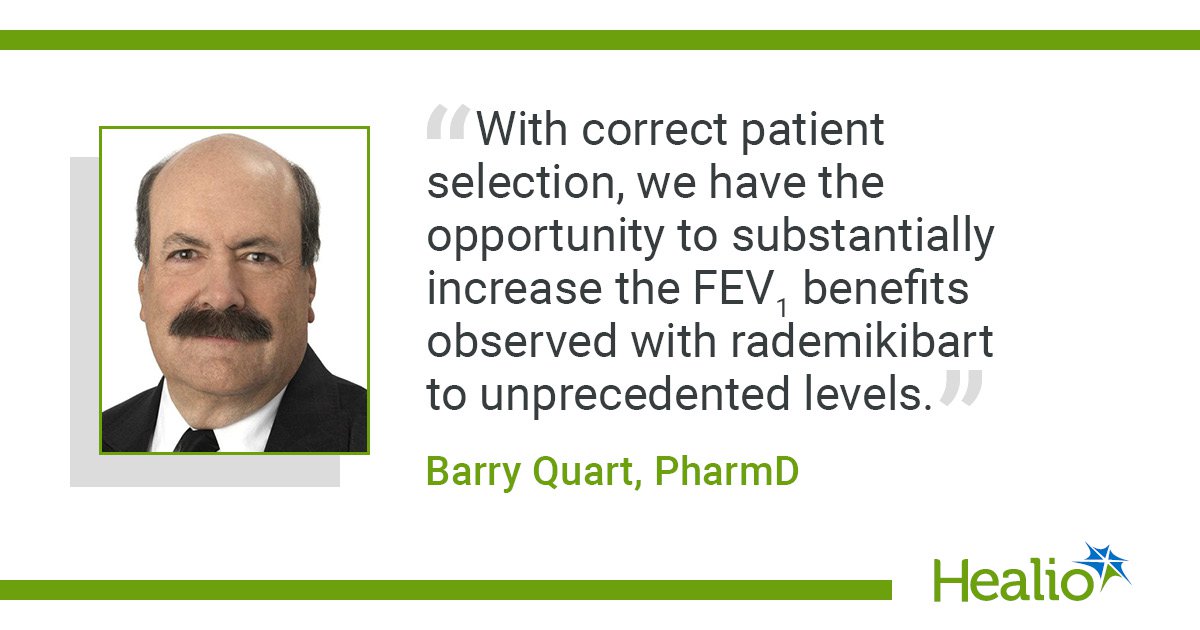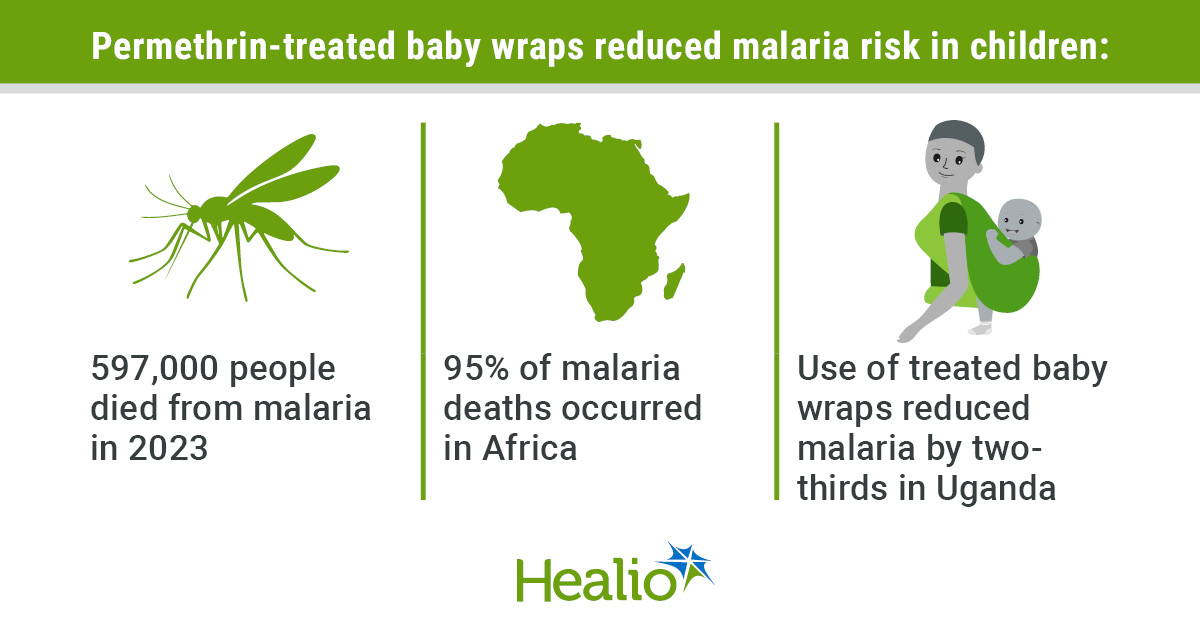October 08, 2025
6 min read
Key takeaways:
- A high eosinophil count was classified as at least 300 cells/μL, and a high FeNO was classified as at least 25 ppb.
- FEV1 response to rademikibart differed based on enrollment in Poland vs. rest of the world.
Among adults with moderate to severe asthma receiving rademikibart, those with a high eosinophil count plus high fractional exhaled nitric oxide had the largest improvements in FEV1 and asthma control, according to a post hoc analysis.
This study was presented as a poster at the European Respiratory Society International Congress.

“With correct patient selection, we have the opportunity to substantially increase the FEV1 benefits observed with rademikibart to unprecedented levels (placebo-adjusted increase of 488 mL in patients with high eosinophils and high FeNO),” Barry Quart, PharmD, CEO and director of Connect Biopharma, told Healio.
In a post hoc analysis of a global, multicenter, randomized, double-blind, placebo-controlled phase 2b trial on rademikibart (CBP-201, Connect Biopharma), Quart and colleagues evaluated 322 adults with uncontrolled moderate to severe asthma who received subcutaneous 150 mg rademikibart, 300 mg rademikibart or placebo every 2 weeks for 24 weeks to determine if benefits seen with the drug in lung function and asthma control differ based on a patient’s eosinophil and FeNO count at baseline.
Researchers specifically assessed the 300 mg dose of rademikibart in this analysis.
“We are continually trying to learn as much as we can from the complete phase 2 study,” Quart said. “A recently published meta-analysis of 22 randomized trials [by Meulmeester and colleagues] highlights the importance of FeNO, so we wanted to share our data showing consistent results.”
All patients in the phase 2b study began with a 600 mg loading dose of rademikibart or placebo, according to the poster. Most patients were enrolled in the United States (67%), followed by Poland/Hungary (19%) and China/South Korea (14%).
As Healio previously reported, adults with moderate to severe persistent asthma receiving rademikibart every 2 weeks showed greater improvements in lung function at week 12 compared with patients assigned placebo. Asthma control also improved with both doses of rademikibart at the 24-week mark.
Results
This population included 54 patients (rademikibart, n = 31; placebo, n = 23) with an eosinophil count of at least 300 cells/μL (high) and a FeNO of at least 25 ppb (high); 86 patients (rademikibart, n = 40; placebo, n = 46) with an eosinophil count less than 300 cells/μL (low) and a FeNO less than 25 ppb (low); 39 patients (rademikibart, n = 18; placebo, n = 21) with a low eosinophil count and high FeNO; and 37 patients (rademikibart, n = 19; placebo, n = 18) with a high eosinophil count and low FeNO.
Among those receiving rademikibart, researchers observed the largest improvement in prebronchodilator FEV1 between baseline and week 24 in the group with a high eosinophil count and FeNO (least-squares mean change, 507 mL), followed by the group with a low eosinophil count plus high FeNO (284 mL), the group with a high eosinophil count plus low FeNO (209 mL) and the group with a low eosinophil count and FeNO (108 mL).
Notably, the high eosinophil and FeNO placebo group only showed an improvement of 19 mL at week 24, which meant the placebo-adjusted difference in least-squares mean with rademikibart was 488 mL.
The poster also reported that no benefit from rademikibart was observed in the low eosinophil and FeNO group, with prebronchodilator FEV1 improved by 127 mL at week 24 with placebo, which was slightly greater than the improvement seen in the low eosinophil and FeNO rademikibart group (placebo-adjusted difference, –19 mL).
Improvement in Asthma Control Questionnaire score between baseline and week 24 in the rademikibart subgroups followed the same pattern as the one found for FEV1. The high eosinophil and FeNO group had the largest improvement (least-squares mean change, –1.54), followed by the low eosinophil plus high FeNO group (–0.99), the high eosinophil plus low FeNO group (–0.89) and the low eosinophil and FeNO group (–0.78).
Each subgroup receiving rademikibart exceeded the minimal clinically important difference of –0.5, according to the poster.
As an additional measure, researchers evaluated the rate of asthma exacerbations in those with a high eosinophil count, as well as those with high FeNO. Importantly, the 300 mg and 150 mg rademikibart groups were combined when collecting this rate.
Among patients with a high eosinophil count, the rate of annualized asthma exacerbations significantly dropped with rademikibart vs. placebo (0.35 vs. 0.94; 63% decrease). This pattern was also found among patients with a high FeNO (rademikibart, 0.24 vs. placebo, 0.77; 69% decrease).
“There has been a major focus on eosinophils for identification of patients with T2-mediated asthma,” Quart told Healio. “Our data and those noted above highlight that FeNO is an independent marker of T2-mediated disease and that the combination of the two markers identifies patients with the absolute best response.
“This will help clinicians make better choices about who gets certain drugs,” he said.
In future studies on chronic asthma, Quart said both eosinophils and FeNO will likely be used as entry criteria instead of only eosinophils.
Geographic difference in response
In addition to the above post hoc analysis, Quart and colleagues conducted another post hoc analysis of the phase 2b trial to determine if lung function response to rademikibart differs based on enrollment in Poland vs. the rest of the world.
Researchers again specifically assessed the 300 mg dose of rademikibart in this analysis.
This study population included 38 Polish patients (rademikibart, n = 21; placebo, n = 17) and 178 patients (rademikibart, n = 87; placebo, n = 91) from the rest of the world.
At baseline, 41.2% (n = 7) of the Polish placebo group and 37.4% (n = 34) of the rest of the world placebo group had a high eosinophil count. In contrast, a low eosinophil count of less than 150 cells/μL was found in 23.5% (n = 4) of the Polish placebo group and 24.2% (n = 22) of the rest of the world placebo group.
Importantly, the Polish patients receiving placebo with a low eosinophil count had high baseline FEV1, according to the poster.
In the rademikibart groups, 66.6% (n = 14) of the Polish patients and 41.4% (n = 36) of the patients from the rest of the world had a high eosinophil count, whereas a low eosinophil count was reported in 9.5% (n = 2) of the Polish group and 24.1% (n = 21) of the rest of the world group.
Between baseline and week 12, researchers found a significant improvement in prebronchodilator FEV1 with rademikibart vs. placebo in the rest of the world cohort (least-squares mean difference, 245 mL; P < .0001) but not in the Polish cohort (–88 mL). Notably, the Polish placebo group had a larger improvement than the Polish rademikibart group (212 mL vs. 125 mL).
“This unusually large placebo response was driven by all four patients who had [eosinophil less than] 150 cells/μL and high FEV1 at baseline,” Quart and colleagues wrote.
“For at least two of the four patients in the Polish placebo group, high response may be related to the twice daily use of inhalers even though one of the patients had 60% FEV1 reversibility at baseline,” they added.
When analyzing only patients with a baseline eosinophil count of at least 300 cells/μL, a similar pattern was found. According to the poster, the rest of the world cohort had a significant improvement in prebronchodilator FEV1 with rademikibart vs. placebo (least-squares mean difference, 391 mL; P < .0001), whereas the Polish cohort did not (99 mL).
Researchers noted that this was also the case in patients with a baseline eosinophil count of at least 150 cells/μL, as there was significant improvement with rademikibart vs. placebo among patients from the rest of the world (least-squares mean difference, 301 mL; P < .0001) but not among patients from Poland (186 mL).
“In Poland, rademikibart-treated patients had milder disease vs. placebo and vs. the Rest of the World subgroup, and despite similar FeNO levels, this baseline imbalance may have biased trial interpretation by attenuating the apparent treatment effect,” according to the poster.
Quart added, “the analysis showing a geographic difference in response rates, with a specific observation that Poland was an outlier was somewhat surprising, although GSK has presented similar data previously and again at this meeting.”
For more information:
Barry Quart, PharmD, can be reached at allergy@healio.com.










